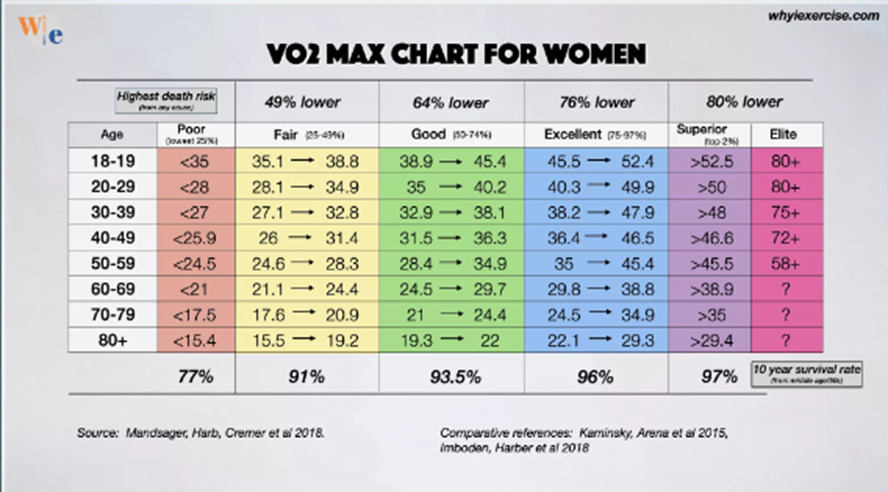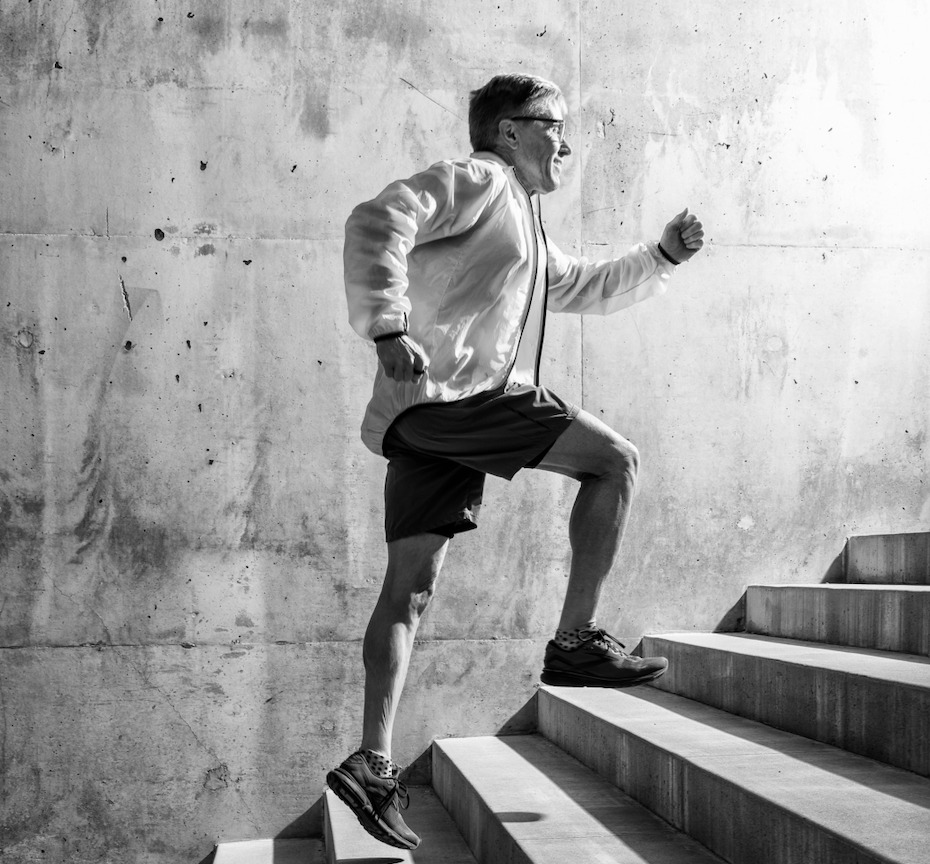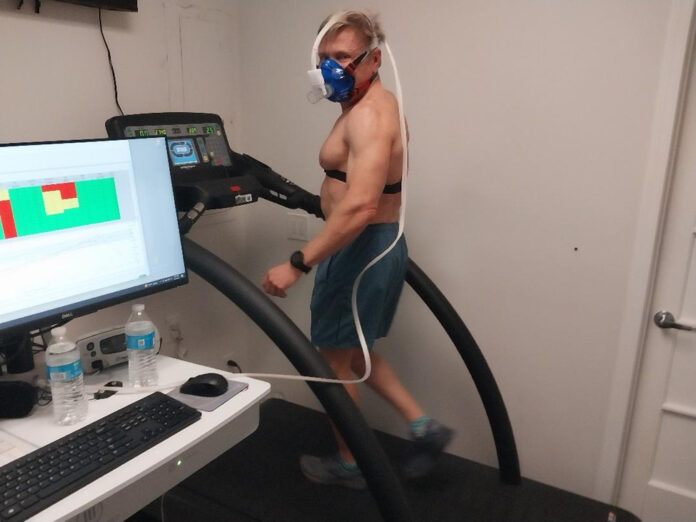Yesterday I had my VO2 max tested. I turned 60 nine months ago. What is VO2 max and why should you care what yours is?
VO2 max is a measure of cardiovascular fitness and refers to the maximum amount of oxygen you can utilize during exercise. VO2 max is measured in milliliters of oxygen consumed in one minute and normalized per kilogram of body weight (mL/kg/min). VO2 max testing is usually performed on a stationary bike or treadmill, utilizes special equipment to measure the gasses we breathe, and requires a maximum effort by the subject.
Why you should care about your VO2 max
The paper cited by Peter Attia, MD when he is speaking about cardiorespiratory fitness is a 2018 paper by Mandsager, et al. that looked at the longevity of 122,007 people, with a mean age of 53.4, from January 1991 to December 2014 with a median follow-up of 8.4 years. (1)
Here is the impressive conclusion from the paper: “Cardiorespiratory fitness is inversely associated with long-term mortality with no observed upper limit of benefit. Extremely high aerobic fitness was associated with the greatest survival and was associated with benefit in older patients and those with hypertension. Cardiorespiratory fitness is a modifiable indicator of long-term mortality, and health care professionals should encourage patients to achieve and maintain high levels of [cardiovascular] fitness.” I inserted the word cardiovascular to emphasize the type of fitness that was being discussed.
In addition to improved longevity, improved VO2 max has functional benefits such as making it easier to climb stairs. High levels of VO2 max may infer a brain benefit also. Another, separate, 2018 study indicated that men with low VO2 max (< 23.7 ml/kg/min, the lowest twenty percent in the study) had a 92% increased risk of dementia as compared with men who had the highest VO2 max. (2)
One of Peter Attia’s aspirations for his patients looking to optimize longevity is to have high levels of VO2 max fitness. Specifically, he uses the standard for a person a decade younger than his patient. (3) Following this guidance, I aspire to a VO2 max of 49 or higher.
I had a VO2 max baseline measurement to compare to. I had my VO2 max measured 18 years ago when I was 42 years old. That test was on a treadmill and my VO2 max was measured at 56.7. As the VO2 max table indicates, this was a really good VO2 max score for any age. I was probably at the peak of my fitness then. I was in the top 1% of my age group as a runner, but the variation in runners in the top 1% is enormous. My best 10k time was 37 minutes and the elite were running 8 to 10 minutes faster than that.


VO2 max charts for men and women from whyiexercise.com
VO2 max is known to decline with advancing age, which is clearly seen in the VO2 max charts. The consensus is that VO2 max decays 10% per decade after age 25. (4) I applied this rate of degradation to my measurement from 18 years ago, and based on this I can now expect a VO2 max of about 47, assuming the same body weight.
I called a couple of places in the Phoenix area to price shop a VO2 max test. Ideally, I would have been re-tested in the same place using the same equipment and protocol to get the most comparable results. However, I had moved and my first test was a long time ago. One place wanted around $200. The place I went to cost about $100 and they accepted my HSA card. If you are cleared by your doctor, there is no special preparation for this test.
I chose to be tested on a treadmill again. Here is the protocol that was used. The treadmill was set at a 1% grade for the entire test. The speed of the treadmill started at an easy walk of 2 miles per hour (mph) and was increased to 3, 4, 5, 6, 7, 8 and 9 mph with two minutes at each speed. In order to measure oxygen and carbon dioxide you have to wear a mask. I did not find this to be much of a burden. At each speed, my VO2 max increased steadily. I knew that 9 mph (6:40 per mile) would be hard for me and I only lasted there for about 20 seconds. By that point, my VO2 max had peaked at 44.6 and the test was complete.

My VO2 max measurement of 44.6 was not quite as good as I was hoping for but, based on this VO2 max measurement and my age, the lab’s app predicted that I would live to 111! My VO2 max goal is still 49 or greater with my current weight which is 4 kg more than 18 years ago. This probably won’t be easy, but I like having goals like this.
There are methods for estimating VO2 max that do not require special equipment or maximal effort. One such method is the Rockport walking test. For this test, you measure how long it takes you to walk one mile and your heart rate. You can then enter your measurements into a calculator to derive an estimated VO2 max. (5)
Some high-end fitness trackers provide a VO2 max estimate. I recently purchased a Garmin 945 smartwatch. This device suggests my VO2 max is 49. When using non-lab-based VO2 max estimates, the trends are what you should pay attention to. If your Rockport or smartwatch VO2 max trend, month over month, is improving, then you know your actual VO2 max is improving and that is what matters.
Improving Your VO2 Max
In “How to Improve Your VO2 Max,” an article from Lifehacker.com, the author suggests a strategy to improve VO2 max that combines building a large aerobic base through a high volume of low intensity exercise along with a much smaller dose of high intensity workouts. (6)
I usually do three to four hours of low intensity exercise in the forms of running, cycling and swimming every week. Low intensity workouts are often labeled zone-two workouts, are aerobic and almost exclusively utilize fat as the primary energy source. A benefit of lab testing VO2 max is that it accurately provides zone training thresholds based on heart rate. For me, if I stay below 130 beats per minute (bpm), I will stay in zone two.
Because of their intensity, you do not want to do more than one or, at most, two high intensity workouts per week.
High intensity workouts are often labeled zone five workouts and are typically above 90% of your maximum heart rate. According to my lab results, for me to get to zone five I have to get my heart rate above 155 bpm. My maximum heart rate measured during the test was 169 bpm.
There are online calculators to help you determine your zone thresholds. (7) Comparing my data, the zone calculators do a reasonable job of establishing training zones.
For my high heart rate, zone five, workouts I perform a running workout at a track with the local triathlon club once per week. The way these workouts are structured is we usually do about twenty minutes of high intensity work broken into two- to six-minute segments. For example, we do six intervals of four minutes of all-out effort and then take a minute or two of rest between each hard interval.
Any activity that raises heart rate to zone two or zone five levels will have cardiovascular and VO2 max benefits. For example, outdoor or indoor cycling or rowing can be used. There are various forms of high intensity interval training (HIIT) that you can utilize for zone five training. Some HIIT approaches use full body movements such as burpees and others use weights like kettlebells and sleds. I have found that traditional weight lifting with typical rest intervals does not raise and keep my heart rates to zone five levels.
I plan on being retested again in about six months. I want to see how much progress I can make to get to my VO2 max goal of 49. Looking forward, I also want to have a VO2 max of greater than 45.5 as a 70-year-old.
Everyone can benefit from improving their VO2 max no matter what their current condition is
I want to emphasize that according to the 2018 Mandsager, et al. VO2 max study, everyone can benefit from improving their VO2 max no matter what their current condition is. In Peter Attia’s article on VO2 max he states that moving VO2 max from low to above average results in a 60% to 70% reduction in mortality. (8) This is a huge improvement and is completely under our control. The 2018 study also says, “Achieving and maintaining very high levels of aerobic fitness may be particularly important in older patients (≥70 years of age) and those with hypertension.”
If you haven’t done challenging aerobic work like this in a while, be smart. Talk with your doctor to get their perspective. If you are healthy enough to do this type of training, start easily and slowly. Getting injured can be a significant setback, but not doing aerobic exercise at all may set you back further.
Written by Greg Damian: I am a 60-year-old author, motivational speaker, health and fitness disruptor and a coach. My book, Abs at 60: The Four Steps to Look and Feel Younger at Any Age was recently released on Amazon. My mission is to assist men over 50 to overcome perceived limits of their age to look and feel younger. I do this by applying my four step DOLR(TM) system that is described in the book. Each chapter has a set of questions for you to answer. You can download a free workbook that includes all of these questions at www.absat60.com
References
- https://jamanetwork.com/journals/jamanetworkopen/fullarticle/2707428
- https://pubmed.ncbi.nlm.nih.gov/29718064/
- https://www.theproactiveathlete.ca/survival-of-the-fittest-vo2-max-as-a-primary-marker-for-longevity/
- https://www.ncbi.nlm.nih.gov/pmc/articles/PMC4968829/#:~:text=Generally%2C%20VO2max%20decreases,1%2C%202%2C%203%5D.
- https://exrx.net/Calculators/Rockport
- https://lifehacker.com/how-to-improve-your-vo2-max-1849681809
- https://www.myprocoach.net/calculators/hr-zones/
- https://peterattiamd.com/how-does-vo2-max-correlate-with-longevity/




I’m 62 years old. My VO2 Max is currently (according to Garmin) 80.0!
The data is acquired via HR and Power Meter.
I had major surgery last year. Cost me a spleen but removed the tumour from my pancreas.
At the moment I’m doing around 3 hours per day training on the bike. 99% in what is known as Zone 2. I don’t strain or force the issue. I don’t over do things. If I feel tired, I stop.
I feed the machine properly and hydrate accordingly. No smoking ever and alcohol is a tiny nip of brandy once in a while.
Thanks for your reply Richard. I am pleased to hear about your recovery from surgery. The Garmin device estimates your VO2 Max but no matter what you are doing great. Keep it up and you’ll be sharing this story twenty, thirty or forty years from now!